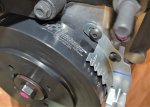Barrman
Well-known member
- 5,351
- 1,998
- 113
- Location
- Giddings, Texas
Todays Topic is injection pump timing. I have owned a 6.2 or 6.5 for almost 11 years now. I have replaced at least 6 injection pumps on varies engines in the same time span. I have also been looking for an accurate way to set the IP timing after pump replacement or to just baseline a running truck.
That sounds easy and simple to someone who grew up with timing lights and distributors. Except it is really a voodoo black magic hole you fall into with the 6.? engines. First there are different timing definitions.
A gear on the crankshaft turns a timing chain with connects to a gear on the camshaft. Then another gear sits on the camshaft gear which turns the injection pump. All 3 gears have big dots on them that have to be lined up in a specific way during engine assembly or timing chain replacement. Really very simple. But any 6.? internet search pops up an amazing amount of people who can’t play connect the dots and are working on an engine. That is one kind of timing.
Inside the IP are many moving parts. They change relationships with each other inside the IP as fuel pressure and rpm change. Totally different timing but just as important as the dots on the gears if not more so. Also something that 99.99% of the people will never touch and can’t change.
The goal is that fuel will be sprayed into the combustion chamber right at or just a hair before the piston gets to the top of the compression stroke. How do you measure that? Some engine makers make it easy. There are markings on a rotating part of the IP and markings on a rotating part of the engine. Basically another version of connect the dots. Line them up and all is well. The M35 multifuel trucks use this method and I approve.
GM did not do this. They wanted to set the timing of the IP fuel delivery based on the actual combustion event. Which is very hard to see inside the engine. I am not sure how they figured it out but they ended up putting a line on the IP housing and a line on the engine block. Then they assumed that every single injection pump would be made to have the exact same tolerances as the ones they tested. So with that in mind they didn’t ever publish timing figures for any of their mechanical injection pumps. Just line up the lines and let it run.
Reality is that each pump has sometimes hugely varied tolerances and each timing chain is of a different length to some extent. Which means fine tuning when the combustion event happens can have a very big effect on how the engine performs. Most people online agree that “going a line width advanced “ is good.
Turning the IP housing as it is mounted in the engine valley toward the drivers side of the vehicle will make the fuel going to the injectors arrive sooner than turning the housing toward the passenger side. But, how much sooner? What timing is just right? How do you measure it?
I have found two ways to measure it:
Several companies make a transducer that clamps to the outside of the metal injection lines. That electrical signal is then sent to a box which magically makes a signal just like spark going down a gasoline engine spark plug wire. Clamp a generic timing light to that wire and point it at the timing tab on the front of the timing cover to see where you are. Just like a gasoline engine. Except it isn’t. Where on the injector line do you put the clamp? Next to the IP or next to the injector? When does actual combustion occur in relation to the fuel going down the pipe? No one knows exactly.
I have such a set up. It gave me a strobe light that worked just like a gas engine timing exercise. But, it was never consistent. Even the same engine in the same truck gave me very varied results each time I tried it. It was good for getting engine rpm only through a rpm showing timing light in my experience. Time for another method.
The other method is probably what GM used from the start. Kent Moore, Snap-On and a few other companies including Ford made devices that put a clear “window” into the glow plug hole. Then a sensor is plugged into that and makes the light of actual combustion the trigger to an electrical signal for a regular timing light. The catch is nobody has made them or their “window” in almost 30 years.
Snap-On went a step further and made a machine called the MT480. They called it the Lumymag. It had the probe in the glow plug hole and a probe that went in the tube on the timing tab to produce an rpm read out. The MT480 had two big analog dials to show rpm and timing advance or retard in degrees. Finding a working MT480 with all of the probes and the adapter to go in the glow plug hole is tough. I bought a set up 5 years ago at what I thought was a good deal. It didn’t work.
Snap-On later came out with a MT1480 lumy mag II. Same idea, different sensors and digital read out. Of course the probes on the MT480 and the MT1480 don’t interchange. It seems there is always at least 1 MT1480 on eBay. They also seem to never have the probes. Last week I saw one where I thought the probes were hidden in a bad photo. I took a chance and bought it.
It showed up yesterday and it had the probes. I hooked it up and it worked! Glorious day. Except the numbers for the timing didn’t make sense. Which brings up the next part of the timing puzzle. What are correct timing numbers? No one knows because GM never published them. Snap-On has a wonderful 18 page manual for the machine but no specs are published.
Another problem is the “offset.” Anyone that has used a timing light knows to aim at the timing tab and where the balancer timing line is strobe lighted is the degrees advance or retarded the timing of the ignition. You ever wonder what those round tubes attached to and at one end of the timing tab since about 1976 is? That round tube is a holder for a timing probe. The exact same timing probe the MT1480 uses.
All 6.? engines have a timing probe holder. All 6.2 engines as far as I can tell have the probe holder offset 9.5°. That value is entered in the MT1480 and it adjust for that. I think but have not been able to verify that the early all mechanical IP 6.5 engines also had a 9.5° offset. So, I put 9.5° in the machine and got 24° advance at idle. What?
There are a few people using the MT1480 that post to wildly different forums about their timing experiences. The generally accepted timing baseline is 8° advanced at idle and somewhere between -2° to +3° at 1400 rpm. I was at 24° at idle. How is it even running? I looked at the timing tab and noticed it gave reading to 16° advanced and that took about an inch of space. Yet, my probe holder was at least 3 inches to the retarded side from the TDC mark. That should be more than 9.5°. I went over to a m1009 and looked at its probe holder. It was almost on top of the TDC mark. So I had the wrong offset for a 2005 GEP 6500.
Doing an internet search for 6.5 diesel timing probe offset introduced me to an entirely new black hole. It seems the DS 4 electronic injection pumps used on all 1994 and newer 6.5 engines have an offset setting inside the IP that has to be set with a special scanner. Nobody needs to hook up a MT1480 so no listed offset that I could locate.
I have a 6.5 timing tab in my class and a 6.2 timing tab as well. I think I will just try and figure out how many millimeters per degree and try and figure out the probe holder offset. I just used 30° yesterday and that gave me a baseline of 3° at idle and -4° at 1400 rpm. I moved it to 5° at idle and -1.5° at 1400 rpm. I have to drive 500 miles the next few days and I will see if it made a difference. Once I know the proper offset, I will fine tune it for boost, turbo lag and EGT.
Unless someone knows the offset. Do share if you do.
That sounds easy and simple to someone who grew up with timing lights and distributors. Except it is really a voodoo black magic hole you fall into with the 6.? engines. First there are different timing definitions.
A gear on the crankshaft turns a timing chain with connects to a gear on the camshaft. Then another gear sits on the camshaft gear which turns the injection pump. All 3 gears have big dots on them that have to be lined up in a specific way during engine assembly or timing chain replacement. Really very simple. But any 6.? internet search pops up an amazing amount of people who can’t play connect the dots and are working on an engine. That is one kind of timing.
Inside the IP are many moving parts. They change relationships with each other inside the IP as fuel pressure and rpm change. Totally different timing but just as important as the dots on the gears if not more so. Also something that 99.99% of the people will never touch and can’t change.
The goal is that fuel will be sprayed into the combustion chamber right at or just a hair before the piston gets to the top of the compression stroke. How do you measure that? Some engine makers make it easy. There are markings on a rotating part of the IP and markings on a rotating part of the engine. Basically another version of connect the dots. Line them up and all is well. The M35 multifuel trucks use this method and I approve.
GM did not do this. They wanted to set the timing of the IP fuel delivery based on the actual combustion event. Which is very hard to see inside the engine. I am not sure how they figured it out but they ended up putting a line on the IP housing and a line on the engine block. Then they assumed that every single injection pump would be made to have the exact same tolerances as the ones they tested. So with that in mind they didn’t ever publish timing figures for any of their mechanical injection pumps. Just line up the lines and let it run.
Reality is that each pump has sometimes hugely varied tolerances and each timing chain is of a different length to some extent. Which means fine tuning when the combustion event happens can have a very big effect on how the engine performs. Most people online agree that “going a line width advanced “ is good.
Turning the IP housing as it is mounted in the engine valley toward the drivers side of the vehicle will make the fuel going to the injectors arrive sooner than turning the housing toward the passenger side. But, how much sooner? What timing is just right? How do you measure it?
I have found two ways to measure it:
Several companies make a transducer that clamps to the outside of the metal injection lines. That electrical signal is then sent to a box which magically makes a signal just like spark going down a gasoline engine spark plug wire. Clamp a generic timing light to that wire and point it at the timing tab on the front of the timing cover to see where you are. Just like a gasoline engine. Except it isn’t. Where on the injector line do you put the clamp? Next to the IP or next to the injector? When does actual combustion occur in relation to the fuel going down the pipe? No one knows exactly.
I have such a set up. It gave me a strobe light that worked just like a gas engine timing exercise. But, it was never consistent. Even the same engine in the same truck gave me very varied results each time I tried it. It was good for getting engine rpm only through a rpm showing timing light in my experience. Time for another method.
The other method is probably what GM used from the start. Kent Moore, Snap-On and a few other companies including Ford made devices that put a clear “window” into the glow plug hole. Then a sensor is plugged into that and makes the light of actual combustion the trigger to an electrical signal for a regular timing light. The catch is nobody has made them or their “window” in almost 30 years.
Snap-On went a step further and made a machine called the MT480. They called it the Lumymag. It had the probe in the glow plug hole and a probe that went in the tube on the timing tab to produce an rpm read out. The MT480 had two big analog dials to show rpm and timing advance or retard in degrees. Finding a working MT480 with all of the probes and the adapter to go in the glow plug hole is tough. I bought a set up 5 years ago at what I thought was a good deal. It didn’t work.
Snap-On later came out with a MT1480 lumy mag II. Same idea, different sensors and digital read out. Of course the probes on the MT480 and the MT1480 don’t interchange. It seems there is always at least 1 MT1480 on eBay. They also seem to never have the probes. Last week I saw one where I thought the probes were hidden in a bad photo. I took a chance and bought it.
It showed up yesterday and it had the probes. I hooked it up and it worked! Glorious day. Except the numbers for the timing didn’t make sense. Which brings up the next part of the timing puzzle. What are correct timing numbers? No one knows because GM never published them. Snap-On has a wonderful 18 page manual for the machine but no specs are published.
Another problem is the “offset.” Anyone that has used a timing light knows to aim at the timing tab and where the balancer timing line is strobe lighted is the degrees advance or retarded the timing of the ignition. You ever wonder what those round tubes attached to and at one end of the timing tab since about 1976 is? That round tube is a holder for a timing probe. The exact same timing probe the MT1480 uses.
All 6.? engines have a timing probe holder. All 6.2 engines as far as I can tell have the probe holder offset 9.5°. That value is entered in the MT1480 and it adjust for that. I think but have not been able to verify that the early all mechanical IP 6.5 engines also had a 9.5° offset. So, I put 9.5° in the machine and got 24° advance at idle. What?
There are a few people using the MT1480 that post to wildly different forums about their timing experiences. The generally accepted timing baseline is 8° advanced at idle and somewhere between -2° to +3° at 1400 rpm. I was at 24° at idle. How is it even running? I looked at the timing tab and noticed it gave reading to 16° advanced and that took about an inch of space. Yet, my probe holder was at least 3 inches to the retarded side from the TDC mark. That should be more than 9.5°. I went over to a m1009 and looked at its probe holder. It was almost on top of the TDC mark. So I had the wrong offset for a 2005 GEP 6500.
Doing an internet search for 6.5 diesel timing probe offset introduced me to an entirely new black hole. It seems the DS 4 electronic injection pumps used on all 1994 and newer 6.5 engines have an offset setting inside the IP that has to be set with a special scanner. Nobody needs to hook up a MT1480 so no listed offset that I could locate.
I have a 6.5 timing tab in my class and a 6.2 timing tab as well. I think I will just try and figure out how many millimeters per degree and try and figure out the probe holder offset. I just used 30° yesterday and that gave me a baseline of 3° at idle and -4° at 1400 rpm. I moved it to 5° at idle and -1.5° at 1400 rpm. I have to drive 500 miles the next few days and I will see if it made a difference. Once I know the proper offset, I will fine tune it for boost, turbo lag and EGT.
Unless someone knows the offset. Do share if you do.





